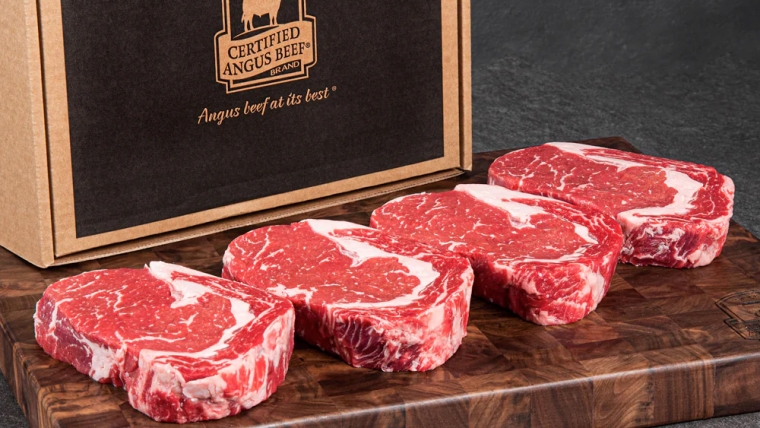
The Certified Angus Beef programme has been running for 47 years since the first sale of product under the CAB brand in 1978. Three years later the American Angus Association voted to wind the programme up, if it hadn’t turned a profit within 12 months. Despite not being profitable after a year, it survived by one vote and today 559,000 tonnes of product are sold in the USA and 54 other countries and six million carcases were CAB certified as meeting the 10 specifications for quality.
The programme is 100% producer owned and governed and 100% packer or exporter funded which is hugely significant in the building of the brand.
These basic facts underline why the Angus breed is such a powerful brand today and at the same time how difficult, expensive and time consuming creating a brand is. Contrast this with the New Zealand experience – on the one hand the Lamb Rosette, highly recognisable as the New Zealand lamb brand, and entirely funded by producer levies, was dropped after many years, because the investment was no longer sustainable, at least without matching exporter contributions.
On the other hand, Taste Pure Nature was introduced to the Californian market in 2020, again funded by producers but with some support from processors. Four years later responsibility for governance and investment in the programme was transferred to the MIA with continued assistance from BLNZ, and the short California programme was replaced by China, more specifically Shanghai. Much too short a time to build a brand in any market.
It remains to be seen how willing the exporters will be to support the programme out of their own marketing budgets, especially when not all of them are prepared to commit. I have already expressed my scepticism about the success of this approach which provoked an angry response from the MIA.
This whole issue raises the old question of whose responsibility it is to market red meat and how to cover the cost. BLNZ has clearly signalled its wish not to continue spending levy payers’ money on generic country of origin promotion, while the exporters are not keen on promotion, unless it is tied directly to their brand.
The main problem is our size and budget relative to the amount we export. Critics point to meat exporters’ shortsighted approach to brand building, but thin margins mean there is very little flexibility in their marketing budget.
My long-held view on the appropriate division of responsibility is that the producers’ role is to invest in the New Zealand red meat brand and the exporters are responsible for their own brands, ensuring their brand activity links closely to any country of origin message. However, this will only have hope of success if all exporters buy into the overall red meat brand and are prepared to commit a percentage of revenue promoting their brands using the nationally agreed message on all promotional material.
The CAB programme has succeeded immensely after slow beginnings because of the determination of all the participants to support it. It is neither an origin nor an exporter brand, but a breed specific campaign to address the declining Angus cattle population in the United States in the 1970s and the deteriorating quality of American beef which had affected consumer satisfaction. It is a success that is highly unlikely ever to be repeated, but the independence of the governance structure provides a suitable investment model.
Silver Fern Farms has committed itself wholeheartedly to building its own brand and, at its recent AGM, stated its value added strategy is ahead of its plans, claiming 5% of its commodity product has moved to the next level of value in a year, enhancing the value of the whole carcase.
Somewhat ironically, this statement came hard on the heels of the decision to take 30 cents per kilo out of the schedule because, in CEO Dan Boulton’s words, the sudden 10% lift in the exchange rate had taken a quarter of the margin. This only emphasises the narrow gap between direct cost and market price which is required to fund administration, finance, marketing, and profits for capital expenditure and dividends.
On the matter of generic country of origin campaigns, I have had contact from an American importer who has expressed frustration with the way TPN was rolled out, saying BLNZ refused to listen to importers that know their market. He insists generic campaigns are “vapid and meaningless to consumers” and money would be better spent on directly promoting individual exporter brands in cooperation with their distributors.
This importer maintains there are only two kinds of marketing programmes: brand development campaigns for which a huge budget is required and campaigns designed to sell product. Because the former is too expensive and takes long-term investment, the affordable alternative is targeted direct marketing programmes that promote sales of specific products and brands. Each market demands different strategies.
While a generic tagline for all meat exports would make sense, it seems logical to leave the branded product marketing to the individual companies.
Current schedule and saleyard prices are available in the right-hand menu of the Rural section of this website.
Y Lamb
Select chart tabs
6 Comments
Good comment Alan
I stayed recently at a back country pub in the NI heavily into Toursim trade. The owner told me he had been very frustrated that the scotch steak he was getting was so variable. He had to ring, drive and visit and try to find someone who could just deliver a product that was consistent. He tried many companies with no luck but finally found an Angus Meats supplier - he now gets a consistent product and his customers are happy as is he.
I sometimes think consistency of product is just as important so when you buy something you are pretty sure you know what you are getting. As a good friend of mine, heavily in the meat marketing game, said you need a consistent high quality product with universal standards. He said the meat we have done this best in is grinding beef as the plants measure the fat content of every carton using an internationally recognised method and ruler.
Grinding beef he said is the most consistent product the red meat sector produces at any meaningful scale.
The grinding meat has everything going for it. It is straightforward efficient processing, packaging, storage and shipping and being frozen of little shelf life constraint. At one end the farm, as manufacturing grade cattle, it is an excellent fit, more or less a by product of dairying courtesy of herd culling. At the other end the market, it is an established, trusted and essential product that provides lean beef to blend in with the fattier domestic product for the gigantic Nth American burger trade. At the end of the day it is a straight out commodity trade and a damn good one to have.
At the other end the market, it is an established, trusted and essential product that provides lean beef to blend in with the fattier domestic product for the gigantic Nth American burger trade. At the end of the day it is a straight out commodity trade and a damn good one to have.
It's a competitive mkt and Maccas U.S. is pretty much sources most of its ground beef domestically. You would think growing mkt share would be challenging and value share even harder. McDs Japan has done well out of latching on to the 'Aussie beef' appeal and perhaps NZ could do something similar in the food service channel in the U.S.
Aye be even better if meat company’s didn’t cross subsidise value from grinding meat to there premium/primal business.
Does that concern then in turn raise the question, the possibility of the dairy industry itself entering into processing its suppliers cattle. After all the foremost operation is of course dairy but having control all the way through, beef as a by product must surely be an interesting prospect. Drawing a long bow here but the dispensing of the high end brands by Fonterra evidences a switch to a priority of commodity trading alongside of which, in simple form, would be grinding beef product.A state of the art plant, dedicated to warm boning to bulk packs would be a straightforward process - slaughter, bone, freeze - without the associated chiller and aging costs being needed in house, as necessary for premium steer cuts.
On the matter of generic country of origin campaigns, I have had contact from an American importer who has expressed frustration with the way TPN was rolled out, saying BLNZ refused to listen to importers that know their market. He insists generic campaigns are “vapid and meaningless to consumers” and money would be better spent on directly promoting individual exporter brands in cooperation with their distributors.
Yes indeed. If you ask most consumers about top of mind beef brands, they will likely be unable to answer. Ask a Japanese about source of origin and beef, expect Australia to be mentioned. That association has built over a long time, from when Japan banned US beef because of mad cow disease. Not just campaigns, but unearned media and word of mouth helped Aussie be adopted and accepted by the shopper and consumer. But it's unlikely that anyone would know a specific Aussie meat brand.
Distributors are crucial as they're the best in understanding the buyer / consumer across each channel - not just supermarkets, but also the food service channel where the buyer may have different need and use cases to a consumer (Coca Cola is not really a B2C business; it's a B2B business). Brand and marketing strategies need to be developed for each channel while ideally having the same same 'brand idea'.

We welcome your comments below. If you are not already registered, please register to comment
Remember we welcome robust, respectful and insightful debate. We don't welcome abusive or defamatory comments and will de-register those repeatedly making such comments. Our current comment policy is here.